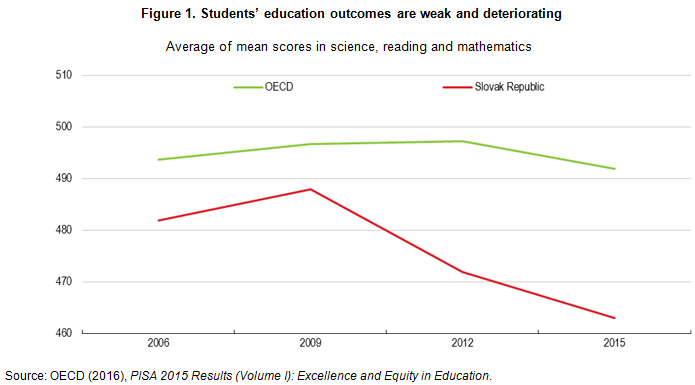Slovakia…it’s time to invest in the future
by Gabriel Machlica, Slovak Republic Desk, OECD Economics Department
The Slovak Republic continues to exhibit robust economic performance. International competitiveness is strong, fiscal and financial policies are prudent, poverty and income inequality are low, and the country’s environmental footprint has improved markedly. Employment is rising, prices have been stable, and the external account is near balance. However, there are persistent, substantial public-sector deficiencies, which weigh on the wellbeing of the population and can undermine the sustainability of the economic expansion. These are mostly visible in terms of education and health-care outcomes.
The Slovak education system is not properly preparing students for the labour market. PISA outcomes for 15 year-old Slovaks are weak in international comparison and have deteriorated over time (Figure 1). At the same time, secondary schools fail to overcome the differences in learning outcomes stemming from students’ socio-economic backgrounds. Almost one-third of 15 year-old Slovak students did not obtain even a basic level of proficiency in assessed subjects. This is worrying, as weaker students have limited access to employment and better paying jobs. Slovak tertiary education is among the weakest in the OECD. University research quality as measured by international rankings is low even in a regional comparison. As a result, an increasing number of students choose to study abroad to get a better education.

Regarding health-care outcomes, Slovakia ranks poorly in international comparisons. Life expectancy at birth is shorter than in countries with similar or lower living standards. Life expectancy at 65 and health-adjusted life expectancy are among the lowest in the OECD. Infant mortality is high and more people in Slovakia die of diseases that could have been prevented (Figure 2). Improving the health-care system could bring large gains in well-being. For example, improving it to the EU level could save about 5000 lives per year.

Over the last decade the Slovak economy has improved markedly in terms of macroeconomic fiscal and financial-stability outcomes. Nevertheless, it is important to undertake significant reform of the public services, especially education and health care, in order to spread the benefits of solid economic performance more equitably across Slovak society.
Further reading:
OECD (2017), OECD Economic Surveys: Slovak Republic 2017, OECD Publishing, Paris, http://dx.doi.org/10.1787/eco_surveys-svk-2017-en
Šiškovič, M. and M. Játi (2015), “Čo skutočne merajú medzinárodné rebríčky vysokých škôl”, Komentár 01/2015, Inštitút vzdelávacej politiky, Ministerstvo školstva, vedy, výskumu a športu SR.
U21 (2016), Ranking of National Higher Education Systems, Melbourne Institute of Applied Economic and Social Research, University of Melbourne.